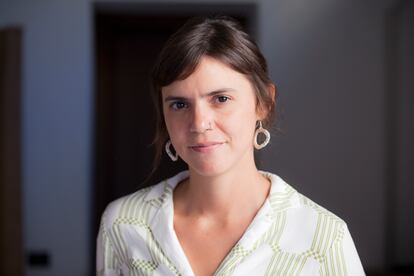Echoes from the Borderland has been four and a half years in the making. It is the brainchild of Mexican writer Valeria Luiselli, who worked with Ricardo Giraldo (director of Mexico City production house La Corriente del Golfo’s podcast division) and Leo Heiblum of Encyclopedia Sónica. The three sought to begin construction on an audio archive that reflects histories of violence on the U.S.-Mexico border. The project’s ultimate goal is a 24-hour sound piece that lasts for the time it takes to travel the border from end to end.
On Wednesday in New York, the project’s Study #1 was presented, a book that comes with a QR code so that it can be read while listening to a 72-minute piece titled Call You When I Get Home. The gallery also presented Study #2, a sound piece divided into four, six-hour segments that each focus on a different border state — California, Arizona, New Mexico, and Texas. That work was commissioned by Humberto Moro and Kamilah N. Foreman in collaboration with the Institute for Studies on Latin American Art, and its segments will be played consecutively on the days the Día Art Foundation in Chelsea is open through March 1.
The starting point for the project was when Foreman, Día Art Foundation’s director of publications, called up Luiselli in 2020, in the middle of the pandemic, to inquire into what the writer was working on. In recent years, Luiselli’s literature has become well-known for its powerful political grounding, and places a special emphasis on questioning immigration policies. Her work has served as a catalyst in the understanding of the migrant experience in the United States, particularly that of children.

In 2018, Luiselli won the American Book Award for Tell Me How It Ends: An Essay in 40 Questions, which told the story of child migrants. She continued to explore the subject in Lost Children Archive, which was a finalist for the National Book Critics Circle Award and the Dublin Literary Award in 2021. “I’m looking into how I could buy Shakespeare,” Luiselli said over the phone that day, referring to the New Mexico ghost town that symbolizes the experiences of migrants who have been displaced and often forgotten by society. “I’m interested,” answered Foreman. Día Art Foundation is known for supporting works that explore the concepts of land and landscape, especially through large-scale projects that interact with natural environments, as in Robert Smithson’s Spiral Jetty in Utah and Walter De Maria’s The Lightning Field in New Mexico.
That initial idea led to the Echoes from the Borderland collective, from which the project takes its name. It could have taken on a thousand different forms, and has evolved over the years. Its three artists chose sound as its medium, currently resulting in a deep, immersive piece capable of transcending spatial-temporal limits.
For Heiblum, the work’s content is not as important as its rhythm, the source of its cohesion. Each documented sound is of equal weight. Its recordings include Luiselli’s written narration, environmental clips (whales, rain, the movement of fish, dogs barking, border control checkpoints) and interviews, which feature the voices of Natalie Diez (winner of the Pulitzer Prize in poetry) and Fred Moten, an academic and theorist.
At first, the collective tried to prove a thesis, asking questions about fear and anger, but the artists quickly came to understand that they weren’t hearing all the people had to say. They decided to change tactics, and the project began to work. When they were asked questions about the environment and land, interviewees felt more freedom to express their feelings. The work came to include conversations about eugenics, the work of all recent presidential administrations in setting up obstacles for immigrants (from Truman through Clinton, Obama and Bush to, of course, Trump) and nuclear testing on the border, among other subjects.
Sign up for our weekly newsletter to get more English-language news coverage from EL PAÍS USA Edition




